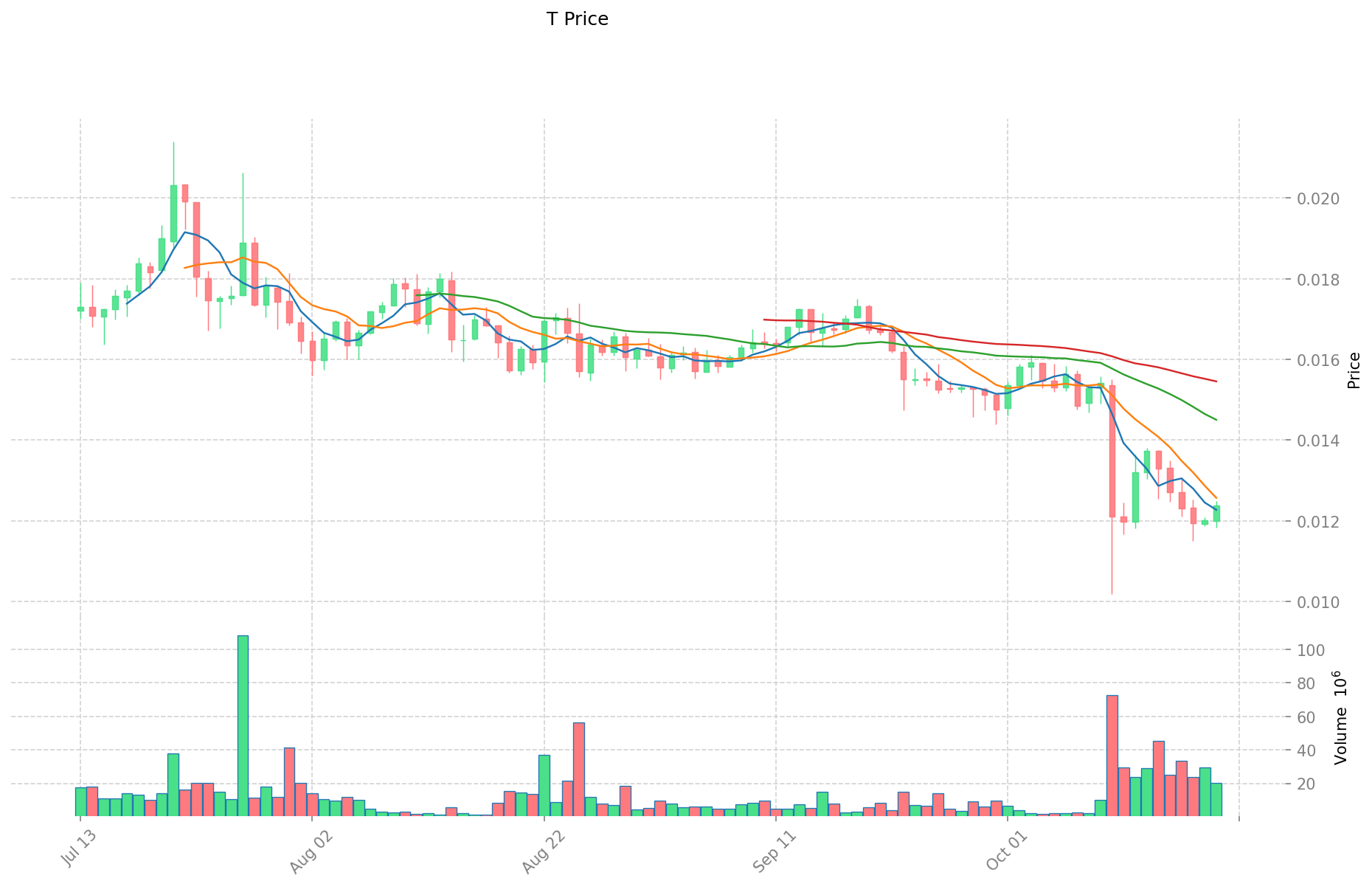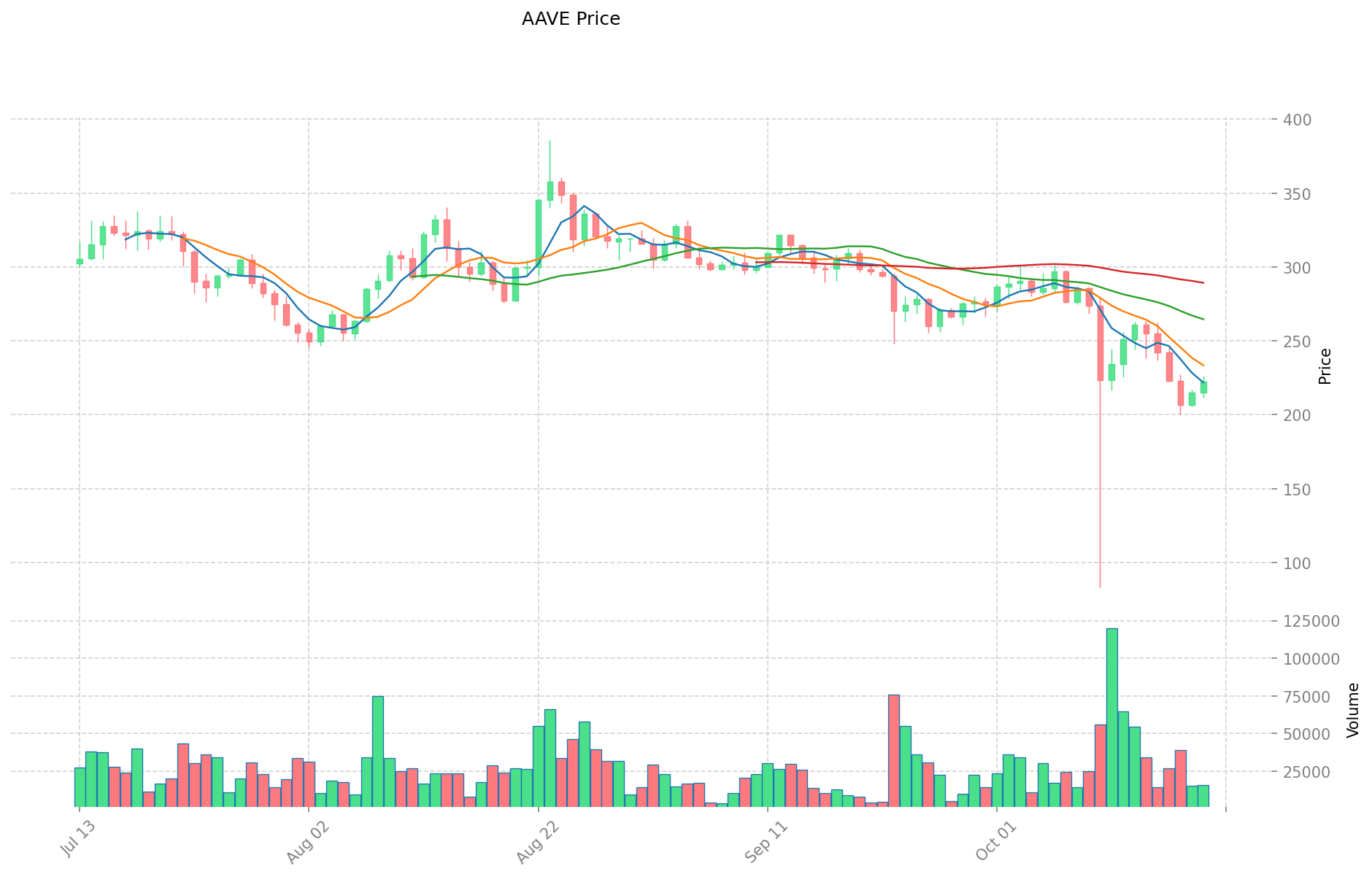T vs AAVE: Exploring the Linguistic Divide in American English
Introduction: Investment Comparison between T and AAVE
In the cryptocurrency market, the comparison between Threshold (T) vs AAVE (AAVE) has always been a topic that investors cannot avoid. The two not only show significant differences in market cap ranking, application scenarios, and price performance, but also represent different positions in crypto assets.
Threshold (T): Launched in 2022, it has gained market recognition for its privacy and security features in blockchain technology.
AAVE (AAVE): Since its inception in 2020, it has been hailed as a leading decentralized lending protocol, becoming one of the cryptocurrencies with the highest global trading volume and market capitalization.
This article will comprehensively analyze the investment value comparison between Threshold vs AAVE, focusing on historical price trends, supply mechanisms, institutional adoption, technological ecosystems, and future predictions, attempting to answer the question that investors care about most:
"Which is the better buy right now?"
I. Price History Comparison and Current Market Status
Threshold (T) and AAVE (AAVE) Historical Price Trends
- 2022: Threshold (T) launched on February 24, 2022, with an initial price of $0.226934 (all-time high).
- 2021: AAVE reached its all-time high of $661.69 on May 18, 2021, during the bull market.
- Comparative analysis: Since their respective peaks, T has declined to a current price of $0.012389, while AAVE has fallen to $221.44, both showing significant drops but with AAVE demonstrating better price retention.
Current Market Situation (2025-10-20)
- Threshold (T) current price: $0.012389
- AAVE current price: $221.44
- 24-hour trading volume: $243,674.99 (T) vs $3,442,507.04 (AAVE)
- Market Sentiment Index (Fear & Greed Index): 29 (Fear)
Click to view real-time prices:
- View T current price Market Price
- View AAVE current price Market Price


II. Core Factors Affecting the Investment Value of T vs AAVE
Supply Mechanism Comparison (Tokenomics)
- Tether (USDT): Fixed supply mechanism pegged to the US dollar at a 1:1 ratio, with supply adjustments based on market demand
- AAVE: Deflationary model with a maximum supply of 16 million tokens, where 80% of protocol fees are used for token burns
- 📌 Historical pattern: AAVE's deflationary mechanism tends to support long-term price appreciation during market expansion phases, while USDT maintains stability regardless of market conditions.
Institutional Adoption and Market Application
- Institutional holdings: USDT has greater institutional adoption as a liquidity and settlement layer, while AAVE is increasingly included in DeFi-focused institutional portfolios
- Enterprise adoption: USDT dominates in cross-border payments and settlement systems; AAVE is primarily utilized in lending/borrowing infrastructure and liquidity provisioning
- National policies: Regulatory scrutiny of stablecoins like USDT is increasing globally, while AAVE faces fewer direct regulatory challenges but operates in the uncertain DeFi regulatory environment
Technical Development and Ecosystem Building
- USDT technical upgrades: Multi-chain expansion across Ethereum, Tron, Solana and other networks to improve accessibility and reduce transaction costs
- AAVE technical development: Protocol V3 implementation with enhanced capital efficiency, risk management features, and cross-chain capabilities
- Ecosystem comparison: USDT serves as primary liquidity pair across DeFi and centralized exchanges; AAVE focuses on lending protocols with expanding integrations across DeFi applications including yield aggregators and liquid staking services
Macroeconomic and Market Cycles
- Performance in inflationary environments: USDT designed to maintain stable value during inflation but faces questions about reserve quality; AAVE potentially benefits from increased DeFi activity during monetary expansion
- Macroeconomic monetary policy: Interest rate increases tend to strengthen USDT's peg stability while potentially reducing capital flows to riskier assets like AAVE
- Geopolitical factors: Cross-border transaction demands benefit USDT usage in restricted markets; global financial uncertainty can drive adoption of both assets for different purposes
III. 2025-2030 Price Prediction: T vs AAVE
Short-term Prediction (2025)
- T: Conservative $0.0111 - $0.0123 | Optimistic $0.0123 - $0.0179
- AAVE: Conservative $181.56 - $221.42 | Optimistic $221.42 - $267.92
Mid-term Prediction (2027)
- T may enter a growth phase, with prices expected in the range of $0.0095 - $0.0206
- AAVE may enter a steady growth phase, with prices expected in the range of $172.94 - $348.47
- Key drivers: Institutional fund inflows, ETFs, ecosystem development
Long-term Prediction (2030)
- T: Base scenario $0.0170 - $0.0246 | Optimistic scenario $0.0246 - $0.0322
- AAVE: Base scenario $236.98 - $353.70 | Optimistic scenario $353.70 - $417.36
Disclaimer: The above predictions are based on historical data and current market trends. Cryptocurrency markets are highly volatile and subject to rapid changes. These projections should not be considered as financial advice or guarantees of future performance. Always conduct your own research and consult with a qualified financial advisor before making investment decisions.
T:
| 年份 | 预测最高价 | 预测平均价格 | 预测最低价 | 涨跌幅 |
|---|---|---|---|---|
| 2025 | 0.01788575 | 0.012335 | 0.0111015 | 0 |
| 2026 | 0.02130562875 | 0.015110375 | 0.010275055 | 21 |
| 2027 | 0.02057504211875 | 0.018208001875 | 0.009468160975 | 46 |
| 2028 | 0.020942843756625 | 0.019391521996875 | 0.013186234957875 | 56 |
| 2029 | 0.02904074334252 | 0.02016718287675 | 0.01532705898633 | 62 |
| 2030 | 0.032231191673621 | 0.024603963109635 | 0.016976734545648 | 98 |
AAVE:
| 年份 | 预测最高价 | 预测平均价格 | 预测最低价 | 涨跌幅 |
|---|---|---|---|---|
| 2025 | 267.9182 | 221.42 | 181.5644 | 0 |
| 2026 | 271.582701 | 244.6691 | 178.608443 | 9 |
| 2027 | 348.469965675 | 258.1259005 | 172.944353335 | 16 |
| 2028 | 360.924540374125 | 303.2979330875 | 181.9787598525 | 36 |
| 2029 | 375.285697505818125 | 332.1112367308125 | 275.652326486574375 | 49 |
| 2030 | 417.364191199612068 | 353.698467118315312 | 236.977972969271259 | 58 |
IV. Investment Strategy Comparison: T vs AAVE
Long-term vs Short-term Investment Strategies
- T: Suitable for investors focused on privacy and security features in blockchain technology
- AAVE: Suitable for investors interested in DeFi lending protocols and ecosystem growth
Risk Management and Asset Allocation
- Conservative investors: T: 20% vs AAVE: 80%
- Aggressive investors: T: 40% vs AAVE: 60%
- Hedging tools: Stablecoin allocation, options, cross-currency portfolio
V. Potential Risk Comparison
Market Risk
- T: Higher volatility due to lower market cap and trading volume
- AAVE: Susceptible to DeFi market trends and overall crypto market sentiment
Technical Risk
- T: Scalability, network stability
- AAVE: Smart contract vulnerabilities, liquidity risks
Regulatory Risk
- Global regulatory policies may have different impacts on both assets, with AAVE potentially facing more scrutiny in the DeFi space
VI. Conclusion: Which Is the Better Buy?
📌 Investment Value Summary:
- T advantages: Privacy and security features, potential for growth in niche market
- AAVE advantages: Established DeFi lending protocol, higher liquidity, and broader ecosystem integration
✅ Investment Advice:
- New investors: Consider AAVE for its established market position and lower volatility
- Experienced investors: Diversify with both T and AAVE, leveraging their different market focuses
- Institutional investors: AAVE may be more suitable due to its higher liquidity and established presence in DeFi
⚠️ Risk Warning: The cryptocurrency market is highly volatile. This article does not constitute investment advice. None
VII. FAQ
Q1: What are the main differences between Threshold (T) and AAVE? A: Threshold (T) focuses on privacy and security features in blockchain technology, while AAVE is a leading decentralized lending protocol. T has a lower market cap and trading volume, while AAVE has a more established presence in the DeFi ecosystem.
Q2: Which cryptocurrency has shown better price performance historically? A: AAVE has demonstrated better price retention compared to Threshold (T). Since their respective all-time highs, T has experienced a more significant price decline than AAVE.
Q3: How do the supply mechanisms of T and AAVE differ? A: Threshold's (T) supply mechanism is not specified in the given information. AAVE has a deflationary model with a maximum supply of 16 million tokens, where 80% of protocol fees are used for token burns.
Q4: What are the key factors affecting the investment value of T and AAVE? A: Key factors include supply mechanisms, institutional adoption, market application, technical development, ecosystem building, and macroeconomic conditions such as inflation and monetary policy.
Q5: What are the price predictions for T and AAVE by 2030? A: By 2030, T is predicted to reach $0.0170 - $0.0322, while AAVE is expected to reach $236.98 - $417.36 in optimistic scenarios. However, these predictions are subject to market volatility and should not be considered financial advice.
Q6: How do the investment strategies for T and AAVE differ? A: T is suitable for investors focused on privacy and security features, while AAVE is better for those interested in DeFi lending protocols. Conservative investors might allocate 20% to T and 80% to AAVE, while aggressive investors might choose 40% T and 60% AAVE.
Q7: What are the potential risks associated with investing in T and AAVE? A: Both face market risks, with T experiencing higher volatility due to lower market cap. Technical risks include scalability for T and smart contract vulnerabilities for AAVE. Regulatory risks may affect both, with AAVE potentially facing more scrutiny in the DeFi space.
Share
Content